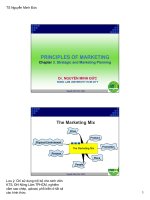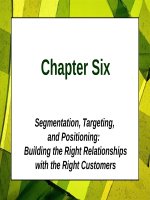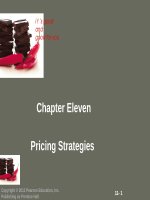Lecture Principles of Marketing - Chapter 12: Communicating customer value
Bạn đang xem bản rút gọn của tài liệu. Xem và tải ngay bản đầy đủ của tài liệu tại đây (244.85 KB, 38 trang )
Chapter Twelve
Communicating Customer Value:
Advertising, Sales Promotion, and
Public Relations
Roadmap: Previewing the Concepts
1. Discuss the process and advantages of
integrated marketing communications.
2. Define the five promotion tools and discuss
the factors that must be considered in
shaping the overall promotion mix.
3. Describe and discuss the major decisions
involved in developing an advertising
program.
4. Explain how sales promotion campaigns are
developed and implemented.
5. Explain how companies use public relations
to communicate with their publics.
Copyright 2007, Prentice Hall, Inc.
12-2
Case Study
CP + B: An Unusual Success Story
The Agency
The Tactics
Has recently won both
multiple creative awards
and several major
advertising accounts.
Located in South Beach,
FL, far removed from
mainstay agencies on
Madison Avenue in NY.
Agency philosophy:
“Anything and everything
is an ad.”
Heavy focus on guerilla
tactics, unconventional
uses of media, and holistic
marketing strategies while
TV is used only sparingly.
Street level research helps
develop creative appeals.
Tries to start a consumer
movement behind the
brand, and campaigns go
well beyond advertising.
The Marketing Communications
(Promotion) Mix
Advertising
Sales Promotion
Public Relations
Personal Selling
Direct Marketing
New Communications Realities
Mass markets have fragmented,
leading to a shift away from mass
marketing.
Improvements in information
technology are speeding movement
toward segmented marketing.
These factors have shifted the
marketing communications model.
– Less broadcasting
– More narrow casting
Integrated Marketing
Communications
Using IMC, the company carefully
integrates and coordinates its many
communication channels to deliver a
clear, consistent, and compelling
message about the organization and its
brands.
– Several factors influence the choice of
promotional tools.
Advertising
Can reach masses of geographically
dispersed buyers.
Can repeat a message many times.
Is impersonal, one-way
communication.
Can be very costly for some media
types.
Personal Selling
Involves personal interaction between
two or more people.
Most effective tool at building
preferences, convictions and actions.
Allows relationship building.
Most expensive promotion tool;
requires long-term commitment.
Sales Promotion
Wide assortment of tools.
Attracts consumer attention.
Offers strong incentives to buy.
Invites and rewards quick consumer
response.
Effects are short-lived.
Public Relations
Very believable.
Reaches people who avoid salespeople
and ads.
Can dramatize a company or product.
Tends to be used as an afterthought.
Planned use can be effective and
economical.
Direct Marketing
Many forms that share four primary
characteristics:
– Nonpublic
– Immediate
– Customized
– Interactive
Well suited to highly targeted
marketing.
Promotion Mix Strategies
Push Strategy
– Producer directs its marketing activities
toward channel members to induce them
to carry the product and promote it to the
final consumers.
Pull Strategy
– Producer directs its marketing activities
toward final consumers to induce them to
buy the product.
Advertising
Advertising has been used for centuries.
U.S. advertisers spend more than $264 billion
each year; worldwide spending approaches
$550 billion.
Advertising is used by:
–
–
–
–
–
Business firms
Nonprofit organizations
Professionals
Social agencies
Government
Major Advertising Decisions
Setting advertising objectives
Setting the advertising budget
Developing advertising strategy
Evaluating advertising campaigns
Setting Advertising Objectives
Advertising Objective:
– specific communication task to be
accomplished with a specific target
audience during a specific period of time.
Classified by Purpose:
– Inform
– Persuade
– Compare
– Remind
Setting the Advertising Budget
Affordable method
Percentage-of-sales method
Competitive-parity method
Objective-and-task method
Developing Advertising Strategy
Consists of two major elements:
– Creating advertising messages
• Message strategy and message execution must
break through the clutter.
– Selecting advertising media
• Set reach, frequency, and impact goals.
• Choose among major media types.
• Select specific media vehicles.
• Decide on media timing.
The Message Strategy
Identify customer benefits
Develop compelling creative concept—
the “Big Idea”
Advertising appeals should be:
meaningful, believable, and distinctive
Message Execution
Slice of Life
Lifestyle
Fantasy
Mood or Image
Musical
Personality
Symbol
Technical
Expertise
Scientific
Evidence
Testimonial or
Endorsement
Message Execution
Choose a tone
Use memorable, attention-getting
words
Choose correct format elements
– Illustration
– Headline
– Copy
Setting Media Objectives
Reach
– Percentage of people exposed to ad.
Frequency
– Number of times a person is exposed to
advertisement.
Media Impact
– The qualitative value of a message
exposure through a given medium.
Choosing Media Type
Factors to consider when selecting
media type:
– Medium’s impact
– Message effectiveness
– Cost
Choosing Media Vehicles
Media vehicles:
– Specific media within each general media
type
Factors to consider:
– Cost
– Audience quality
– Audience attention
– Editorial quality
Deciding on Media Timing
Must decide how to schedule the
advertising over the course of a year.
– Follow seasonal pattern
– Oppose seasonal pattern
– Same coverage all year
Choose the pattern of the ads
– Continuity
– Pulsing
Evaluating Advertising
Measure the communication effects of
an ad—“Copy Testing”
Measure the sales effects of an ad
– Is the ad increasing sales?









